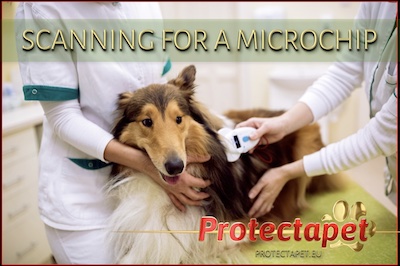Micro-chipping is the relatively “new” form of animal identification. Previously, methods of animal identification were by the use of health cards, animal census, genealogical control (pedigrees) and by tattoo. It is now required by law that all cats and dogs in Spain must have their identification registered by means of “micro-chipping” this is a standardised electronic identification system. There are two factors to this system of identification, the microchip itself and the database called “Registro de Animales de Compañía”, where the information is stored. This information can easily be retrieved and updated remotely using a micro-chip reading device.
Cats & Dogs need to be microchipped in Spain under article 11 of Ley Proteccion los Animales, which can be found on the Spanish government website (Gobierno de España) and it requires all cats and dog´s identities to be registered on the municipal database of your region in Spain. Equally, you must notify the registry if the ownership of your pet changes, your pet passes, or your pet is lost. On a very basic level, if your pet is lost, their microchip will be the key to being happily reunited with your pet. This is because when a stray animal is found, most responsible people and also the animal shelters will look to see if the pet is chipped. They will use a microchip reader to identify the pet and retrieve contact information for the registered owner. Providing that the information in the database is correct, you will be contacted with the good news!
The easiest way to update your pet´s microchip is to visit your vet, where they can make the changes that are necessary. It is also very important for you to know that you must update the registry if your pet is ever missing, failure to do so could mean that it is assumed that you have abandoned your pet. If you are found guilty of “Pet abandonment” in Spain, you could well receive a hefty fine with a possible maximum of 30,000€!! This is because under the new animal welfare laws in Spain, abandoning a dog is considered a criminal offence. With so many abandoned dogs in Spain, the Spanish government have updated the laws to help control and reduce this problem. We must consider the suffering that these dogs are exposed to, not to mention the dangers to society such as causing car accidents.
The microchip must be administered at a Veterinary Clinic within 3 months of birth. The microchip is implanted using a sterile applicator under the skin, usually at the left side on the back of your pet´s neck. It is considered to be a quick and painless procedure. The chip is made with electronic elements that hold data in the form of alphanumeric code and is cased in a bio-compatible plastic capsule. All veterinary clinics that perform this procedure will have the associated “reader” as well as the necessary government organisations and many animal shelters. This makes it easy to scan and identify the animal anywhere in Spain.
Microchipping is quick, reliable and permanent. The simplicity of the system makes it easy for the data to be continually guaranteed and controlled on a centralized and municipal database alongside other databases.

Well, that would be the usual information about you as the owner of the pet, such as name and contact information. Then, of course your pets name, birth date, breed and characteristics alongside the record of the vaccinations they have had. Your vet will tell you what forms of identification you will need to bring with you to the appointment.
P.P.P. stands for ‘Perros Potencialmente Peligrosas’ in Spanish, meaning potentially dangerous dogs. This includes breeds such as Rottweilers, Pitt Bull Terriers and Akita Inu´s as well as any breed of dog over 20kg. A dog can also be classified as P.P.P. by your vet if they show a propensity to be aggressive. These dogs, the same as any other dog must be micro-chipped under Spanish law.
As mentioned earlier, you will need to visit your local Veterinary Clinic for the administration and registration of your pet´s microchip. The price will often vary depending on the Clinic and the region in which you live. You can probably expect to pay between 30-60€ however, it is always best to enquire first. It is also worth noting that if you rescue a pet from a shelter, micro-chipping and also some vaccinations are often included in the adoption fees!
Yes! So please beware, fines for not having your pet microchipped and registered could be between 1.500€ - 3.000€. The Spanish government are taking the issue of pet registration seriously, and are demonstrating this by the level of fines that could be potentially issued. We as pet owners should see this as a very good reason to microchip our pets alongside the obvious reasons, such as wanting to be re-united quickly and easily with a lost or stolen pet.
We sure do! You can take out a pet healthcare plan for your pet as soon as they are over 8 weeks old! We cover the lovely senior Pets too, with immediate cover for accidents and emergencies. Please call for a quote or use our easy online quote facility.
We hope you found this article interesting and share worthy, please do contact us if you feel we may have missed something or if you feel you can add something interesting. Care has been taken to ensure that the information in this article is correct at the time of publishing, however, like most things, the information contained within them can change quite rapidly. Your feedback is, as always very much appreciated!
Copyright and all rights reserved, Protectapet, The European Pet Healthcare management Organisation.
this article about Micro-chipping your Pets in Spain has been written in collaboration with Tangalina and White Mouse Media on behalf of Protectapet.